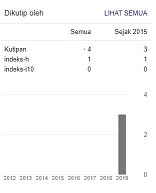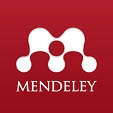PERAN KEMAMPUAN INOVASI UNTUK MENINGKATKAN KINERJA USAHA KECIL MENENGAH (UKM)
Abstract
Keywords
Full Text:
PDFReferences
Alegre, J. and R. Chiva, 2008, “Assessing the Impact of Organizational Learning Capability on Product Innovation Performance: An Empirical Test,” Technovation, 28, 315-326.
Allred, B.B. and K.S. Swan, 2005, “The Mediating Role of Innovation on The Influence of Industry Structure and National Context on Firm Performance,” Journal of International Management, Vol. 11, No.3, p.p.229-252.
Anderson, J.C. and D.W. Gerbing, 1988, “Structural Equation Modeling in Practice: A Review and Recommended Two Step Approach,” Psychological Bullentin, Vol. 103, p.p.411-423.
Aragón-Correa, J.A. and V.J. García-Morales, 2007, “Leadership and Organizational Learning's Role on Innovation and Performance: Lessons from Spain,” Industrial Marketing Management, Vol. 36, No.3, p.p.349-359.
Baker, W.E. and J.M. Sinkula, 1999, “The Synergistic Effect of Market Orientation and Learning Orientation on Organizational Performance,” Journal of The Academy of Marketing Science, Vol. 27, No.4, p.p.411-427.
Benitez-Amado, J., M.N. Perez-Arostegui, and J. Tamayo-Torres, 2010, “Information Technology-Enabled Innovativeness and Green Capabilities,” Journal of Computer Information System, p.p.87-96.
Calantone, R.J., S.T. Cavusgil, and Y. Zhao, 2002, “Learning Orientation, Firm Innovation Capability, and Firm Performance,” Industrial Marketing Management, Vol. 31, p.p.515-524.
Chandler, G..N., K. Chalon, and W.L. Douglas, 2000, “Unraveling The Determinant and Consequences of An Innovation-Supportive Organizational Culture,” Entrepreneurship theory and practice, p.p.59-76.
Covin, J.G. and D.P. Slevin, 1991, “A Conceptual Model of Entrepreneurship as Firm Behaviour,” Entrepreneurship theory and practice, p.p.7-25.
Damanpour, F., 1991, “Organizational Innovation: A Meta-Analysis of Effects of Determinants and Moderators,” Academy of Management Journal, Vol. 34, p.p.555-590.
Delaney, J.T. and M.A. Huselid, 1996, “The Impact of Human Resource Management Practices on Perceptions of Organizational Performance,” Academy of Management Journal, Vol. 39, No.4, p.p.949-969.
Fiol, C.M. and M.A. Lyles, 1985, “Organizational Learning,” Academy of Management review, Vol. 10, No.4, p.p.803-813.
Fornell, C. and D.F. Larcker, 1981, “Evaluating Structural Equation Models with Unobservable Variabels and Measurement Error,” Journal of Marketing Research, Vol. 18, p.p.39-50.
Hult, G.T.M., O.C. Ferrell, and R.F. Hurley, 2002, “Global Organizational Learning Effects on Cycle Time Performance,” Journal of Business Research, Vol. 55, p.p.377-387.
Hult, G.T.M., R.F. Hurley, and G.A. Knight, 2004, “Innovativeness: Its Antecedents and Impact on Business Performance,” Industrial Marketing Management, Vol. 33, No.5, p.p.429-438.
Hurley, R.F. and G.T.M. Hult, 1998, “Innovation, Market Orientation, and Organizational Learning: An Integration and Empirical Examination,”Journal of Marketing, Vol. 62, No.3, p.p.42-54.
Hooper, D., J. Coughlan, and M.R. Mullen, 2008, Structural Equation Modelling: Guidelines for Determining Model Fit,” The Electronic Journal of Business Research Methods, Vol. 6, No.1, p.p.53-60.
Jiménez-Jiménez, D. and R. Sanz-Valle, 2011, “Innovation, Organizational Learning, and Performance,” Journal of Business Research, Vol. 64, No.4, p.p.408-417.
Kaplan, D., 2000, Structural Equation Modeling Foundation and Extensions. London: Sage Publication.
Kleijnen, M., K.D. Ruyter, and M. Wetzels, 2007, “An Assessment of Value Creation in Mobile Service Delivery and The Moderating Role of Time Consciousness,” Journal of Retailing, Vol. 83, No.1, p.p.33–46.
Lee, H. and B. Choi, 2003, “Knowledge Management Enablers, Processes, and Organizational Performance: An Integrative View and Empirical Examination,” Journal of Management Information Systems, Vol. 20, p.p.179-228.
Lee, J.S. and C.J. Hsieh, 2010, “A Research in Relating Entrepreneurship, Marketing Capability, Innovative Capability, and Sustained Competitive Advantage,” Journal of Business & Economics Research, Vol. 8, No.9, p.p.109-119.
MacCallum, R.C., M.W. Browne, and H.M. Sugawara, 1996, “Power Analysis and Determination of Sample Size for Covariance Structure Modeling,” Psychological methods, Vol. 1, No.2, p.p.130-149.
Nasution, H. N., F.T. Mavondo, T.M. Felix, J.M. Margaret, and O.N. Nelson, 2011, “Entrepreneurship: Its Relationship with Market Orientation and Learning Orientation and As Antecedents to Innovation And Customer Value,” Industrial Marketing Management, Vol. 40, No.3, p.p.336-345.
Podsakoff, P.M., S.B. MacKenzie, J.Y. Lee, and N.P. Podsakoff, 2003, “Common Method Biases in Behavioral Research: A Critical Review of The Literature and Recommended Remedies,” Journal of Applied Psychology, Vol. 88, p.p.879-903.
Ray, G., W.A. Muhanna, and J.B. Barney, 2005, “Information Technology and The Performance of The Customer Service Process: A Resource-Based Analysis,” MIS Quarterly, Vol. 29, No.4, p.p.625-652.
Real, J. C., A. Leal, and J.L. Rolan, 2006, “Information Technology As A Determinant of Organizational Learning and TechnologicalRhodes, J., R. Hung, P. Lok, B.Y. Lien, and C.M. Wu, 2008, “Factors Influencing Organizational Knowledge Transfer: Implication for Corporate Performance,” Journal of Knowledge Management, Vol. 12, No.3, p.p.84-100.
Roberts, P.W., 1999, “Product Innovation, Product–Market Competition and Persistent Profitability in The U.S. Pharmaceutical Industry,” Strategic Management, Vol. 20, No.7, p.p.655.
Rogé, J.N., J. Hughes, and P.N. Simpson, 2011, “Learning to Thread The Needle: Information Technology Strategy,” The journal of computer information systems, Vol. 52, No.1, p.p.76-86.
Sharma, R., P. Yetton, and J. Crawford, 2009, “Estimating The Effect of Common Method Variance: The Method-Method Pair Technique with An Illustration from TAM Research,” MIS Quarterly, Vol. 33, No.3, p.p.473-490.
Sinkula, J.M., W.E. Baker, and T. Noordewier, 2001, “A Framework for Market-Based Organizational Learning Linking Values, Knowledge, and Behaviour,” Journal of The Academy of Marketing Science, Vol. 24, No.4, p.p.305-318.
Slater, S.F. and J.C. Narver, 1995, “Market Orientation and The Learning Organization,” Journal of Marketing, Vol. 59, p.p.63-74.
Tarafdar, M. and S.R. Gordon, 2007, “Understanding The Influence of Information Systems Competencies on Process Innovation: A Resource-Based View,” The Journal of Strategic Information Systems, Vol. 16, No.4, p.p.353-392.
Wang, C.L., 2008, “Entrepreneurial Orientation, Learning Orientation, and Firm Performance,” Entrepreneurship Theory and Practice, p.p.635-657.
Wang, Z. and N. Wang, 2012, “Knowledge Sharing, Innovation and Firm Performance,” Expert Systems with Applications, Vol. 39, No.10, p.p.8899-8908.
White, M.A. and G..D. Bruton, 2011, The Management of Technology and Innovation : a Strategic Approach, Australia: South-Western: Cengage Learning.
Wiklund, J. and D. Shepherd, 2005, “Entrepreneurial Orientation and Small Business Performance: A Configurational Approach,” Journal of Business Venturing, Vol. 20, No.1, p.p.71-91.
Yang, J, 2011, “Innovation Capability and Corporate Growth: An Empirical Investigation in China,” Journal of Engineering and Technology Management, p.p.1-13.
DOI: http://dx.doi.org/10.53712/jmm.v2i20.272
Refbacks
- There are currently no refbacks.
Indexing:
Aliansi:
Reference Manager:
View Statistic
Published by Prodi Manajemen Fakultas Ekonomi Universitas Madura
Jl. Raya Panglegur Km 3,5 Pamekasan
Phone: (0324) 322231
website: http://ejournal.unira.ac.id/index.php/jurnal_makro_manajemen/index
Email: makro@unira.ac.id
MAKRO by Universitas Madura is licensed under a Creative Commons Attribution 4.0 International License.







